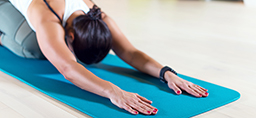
Whether you’re a home-bound fitness enthusiast who wants to stay in shape or a newbie hoping to get in shape, it’s easy to establish an inexpensive workout area in your home.
And for most people, a free workout is just a click away.
You can hop on the internet for a video or clear some space in front of the TV and stream it.
“It’s really nice to do that without having to purchase any equipment,” said Jacob Reisner, DO, a specialist in non-surgical orthopedic sports medicine at Spectrum Health.
YouTube has a host of free workouts, including yoga and high-intensity exercises for training and stretching. The programs are designed for all levels—novice to expert.
Older adults, particularly those over age 65, can find balance workouts to help prevent falls.
These include yoga, qi gong and tai chi. The exercises involve slow but helpful movements that can adequately challenge even a more fit individual.
At-home solutions
Another economic way to stay in shape? Establish a calisthenics program of pushups, sit-ups and lunges, Dr. Reisner said. Use a nearby wall, the floor or a chair.
The stairs make an excellent medium for strengthening leg muscles.
With minimal effort, you can enhance these workouts.
If there’s just one piece of equipment you should buy, aim for dumbbell weights. The cost will depend on where you buy them, but generally a used set is the least expensive option.
A few other pieces of low-cost equipment to add:
- A yoga mat to use when watching exercise videos
- A stability ball for various exercises (this can double as an office chair)
- Resistance bands
Resistance bands are elastic strips that vary in strength based on their color. They’re an affordable alternative to dumbbells and they’re useful for almost any type of resistance training.
Perfect timing
If you’ve typically been sedentary, you should check with your primary care provider before starting any new workout routine, Dr. Reisner said.
Depending on your fitness level, the amount of time to devote to your workout will vary.
If you’re not accustomed to much activity, even a 10-minute workout will deliver results.
The American College of Sports Medicine recommends at least 150 minutes of moderate exercise per week for most people. For those who do vigorous exercising, the recommendation is 75 minutes a week.
High-intensity workouts have the similar health benefits, but they save time.
In general, Dr. Reisner said any workout should strike a balance between running, calisthenics and resistance training.
“Inexpensive home gyms can have many different looks, but the most important thing is to develop an individualized plan that works for you,” he said.
 /a>
/a>
 /a>
/a>
 /a>
/a>